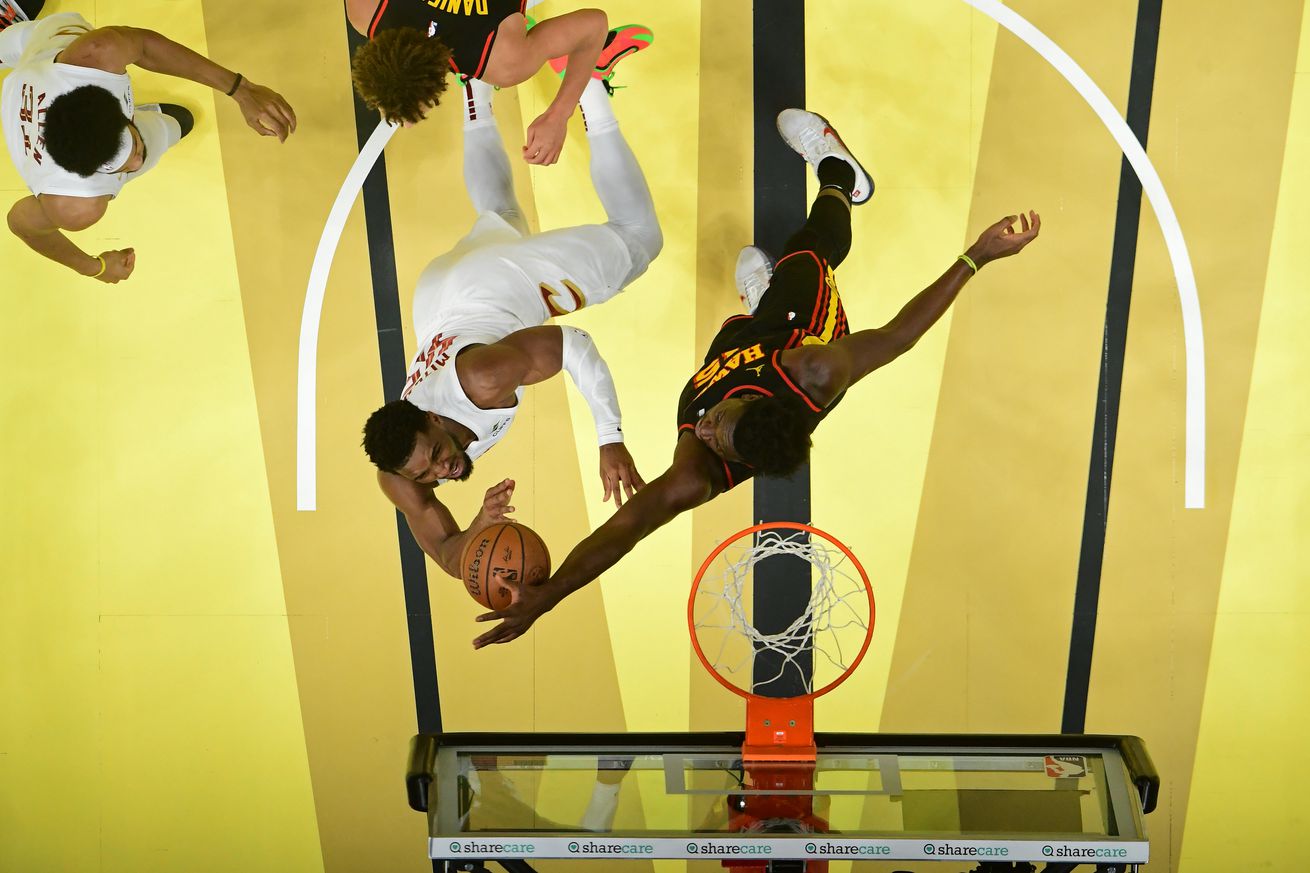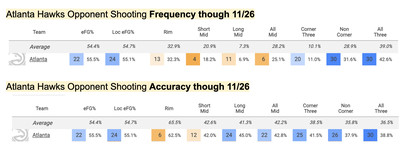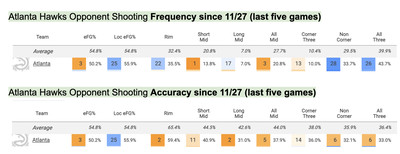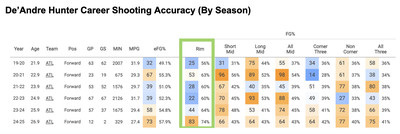
Analyzing the Hawks’ five-game win streak.
After going 7-11 to start the 2024-25 NBA season, the Atlanta Hawks made it five wins in a row after Wednesday night’s victory over the Milwaukee Bucks (who entered the contest riding an impressive seven-game winning streak of their own).
The Hawks have now picked up several impressive victories against the upper echelon of the Eastern Conference this season, beating the Cleveland Cavaliers (twice), Boston Celtics, New York Knicks in addition to Milwaukee, and it’s safe to say that their recent play has put the rest of the NBA community on notice.
The Hawks’ franchise-record streak of 25+ assists games now stands at 15 in a row. They are on the precipice of becoming a top-15 defensive team. Dyson Daniels was just named as the inaugural Eastern Conference Defensive Player of the Month, and continues to hold a comically large lead in total deflections on the season. De’Andre Hunter is playing the best basketball of his career (more on this below). Jalen Johnson continues to improve by the game (and is one just 10 players with a usage rate greater than 20% that is averaging over 5 assists per 75 possessions). Zaccharie Risacher is emerging.
Jalen Johnson is one of 10 non-guards (min. 450 minutes played) that are averaging more than 5 assists per 75 and have a usage rate north of 20% this season – joining some very impressive names on this list @The_BBall_Index
One of the best young playmakers in the NBA pic.twitter.com/n7vNwAhh7A
— Hassan Ladiwala (@ladiwala_hassan) December 5, 2024
All in all, there’s a lot to be excited about in Hawks’ land at the moment, and Trae Young hasn’t even found his scoring touch yet!
Today, let’s examine the Hawks’ win streak and take a look at a few key factors behind their recent play.
Contesting 3PT Shots & Continuing to Lock Down the Paint
In stark contrast to the Hawks teams of recent memory, it’s been their play on the defensive end of the floor that’s played the biggest role in Atlanta’s recent success — with the team smothering their opponents to the tune of 105.2 points per 100 possessions over the past five games (the second lowest defensive rating in the league over that span) after allowing 115.7 points per 100 possessions (22nd) through the first 18 games of the season.
As you can glean from the team’s defensive shot profile in the tables below, this drastic improvement largely comes down to their opponent’s eFG% dropping over five percentage points (from 55.5% to 50.2%, per CTG*) over the win streak.
*which does not account for “garbage time”


Hawks’ opponents have finally cooled off from the perimeter (32.6% opponent 3P% over the past five games) after shooting an incredulous 39.9% from three through the first 18 games of the season — and it’s not just a matter of them clanging open looks, either.
While the team has certainly benefited from their opponents’ “wide open”* 3P% falling from 40.5% through Thanksgiving to 35% during the current win streak, Atlanta has also done a far better job of contesting their opponent’s three-point attempts than they were to the start the season.
*How nba.com/stats classifies 3PA’s without a defender within 6-feet of the shooter
Through their first 18 games, the Hawks were conceding “wide open” threes at the fifth highest rate (23.3%) in the league, however over their last five games, they’ve ranked right around the league average (18th, 21.7%) in this category, with their opponents taking nearly two more “tightly contested”* threes per game over this stretch as well.
*How nba.com/stats classifies 3PA’s with a defender within 2-4 feet of the shooter
Something else that stands out when looking at Atlanta’s defensive shot profile is that despite the fact that they have made more of an effort to close out on opposing three-point shooters, this improvement has not come at the expense of their rim protection, as Hawks opponent’s have shot a paltry 59.4% at the rim over the past five games (the second-lowest mark in the NBA since Nov. 27, per CTG).
Defending the rim is the most important aspect of protecting the paint — something that the Hawks have prioritized all season long, ranking sixth in the NBA in paint points allowed per game (45.0) thus far.
Though everyone on the team deserves credit* for the improved interior defense, I’d like to highlight the play of Clint Capela in particular, whose on/off opponent rim FG% impact (-4.2%) ranks ninth amongst the 55 Bigs who have played over 350 minutes this season, per CTG. Hawks’ opponents are shooting just 60.5% at the rim with Capela on the floor, a mark which ranks in the 86th percentile relative to 5-man lineups with at least 100 possessions this season per CTG.
*Defense (moreso than offense, in my opinion) is reliant on ALL FIVE players being connected on the floor
While Dyson Daniels, aka The Great Barrier Thief, has (deservedly, and in character) stolen the headlines regarding Atlanta’s defensive turnaround, Capela has quietly been stellar in his role as well.
Transition Offense
It’s clear that Atlanta’s defense has been the catalyst for their recent win streak, and one of the positive externalities that comes from getting more stops is that it also allows the team to get out and run in transition more often which, in turn, boosts their offensive efficiency*.
*Per cleaningtheglass, the Hawks are scoring 0.95 ppp in the half-court (20th in the NBA) and 1.21 ppp in transition (14th) this season. More transition possessions = good.
Jalen Johnson corner contest, then beats Mobley down the floor for a transition jam.
Easy bucket pic.twitter.com/X4QVlG9DD2
— Hassan Ladiwala (@ladiwala_hassan) November 30, 2024
lovely closeout and contain from Dyson against Spida – forces a miss, which sparks a transition possession for the Hawks.
Easy two for OO pic.twitter.com/j0aZtESqBB
— Hassan Ladiwala (@ladiwala_hassan) November 30, 2024
Through the first 18 games of the season, the Hawks had a transition frequency of 17.6%*, and they were averaging 16.6 fastbreak points per game, the 10th most in the league over that span (and a significant uptick from their average from last season**). Both good marks that fell just shy of great.
*5th highest transition frequency in the league through 11/27, per CTG
**Atlanta averaged just 13.4 fastbreak ppg in 2023-24, which ranked 19th in the NBA last season
Over their last five games however, Atlanta’s transition frequency has ticked all the way up to 19.9% (per CTG), and they are averaging a whopping 22.8 fastbreak points per game — which would both rank no. 1 in the league in their respective categories by a comfortable margin.
“More than anything, when we’re defending, that’s the ticket.” said Quin Snyder after Wednesday night’s win over Milwaukee. “Whether it’s the beginning of the first quarter, third quarter, [or] end of the game… we just [have] to really commit to guarding, and that allows us to get out in transition.”
Atlanta’s offensive rating has increased from 111 points per 100 possessions (21st) through the first 18 games of the season to 116.9 points per 100 possessions (9th) over their five-game win streak, and they’ve been at their best when attacking off of a defensive stop.
De’Andre Hunter: Silencing The Doubters
So, this (shameless plug) has aged well*. There’s been a lot of “we owe De’Andre Hunter an apology” talk from Hawks’ fans online recently to which I chortle and say: “we?”.
*Yes, I admit it’s still very early on
All kidding aside, De’Andre Hunter has played in 10 games since returning from both a knee-injury and a personal matter on November 15th, and though it took him a couple of games to get comfortable, he’s been absolutely magnificent during Atlanta’s recent win streak.
Over the last five games, Hunter is averaging 21.8 points, shooting 54.7% from the floor, 48.5% from three (on 6.6 attempts per game), and 92% from the free throw stripe in 28 minutes per game coming off the bench. He leads the team* in on/off impact during this stretch with the Hawks outscoring opponents by 15.4 points per 100 possessions with Hunter on the floor.
*Amongst Hawks’ with >15 total minutes played over the past five games (Vit Krejci is a +7 in 13 total minutes played (across two games), giving him a net rating of +25.0 in those minutes. This number quite literally means nothing, though here at Peachtree Hoops, we can always take a moment to shout out Vit.)
Looking at Hunter’s shot profile on CTG, though his shot diet hasn’t changed all that much from last season to this one, he’s made tremendous strides in his scoring efficiency at the rim, raising his rim FG% from 64% last season to 74% through his first 12 games of the 2024-25 season.


While part of the reason for this uptick in efficiency is that more of Hunter’s rim field goals have come via an assist* (with Atlanta using him as both a roller and cutter more often this season — as seen in the two clips below), I’ve also been encouraged by how confident Hunter has looked on his drives this season.
*Per CTG, Hunter has been assisted on 83% of his rim-FG’s this season, and increase from last season, when he was assisted on 76% of his rim-FG’s.
The clip below from the Milwaukee game is a really nice drive and score from Hunter off of a sideline out of bounds play.
In this next clip, notice how Hunter sizes up the driving lane, then explodes off the catch, using a head fake to send Cody Martin to the corner-man before finishing over Nick Richards at the basket.
Another nice drive and finish (plus the foul) from the Milwaukee game.
Hunter’s recent play has (stunningly) propelled him all the way up to third in FanDuel’s Sixth Man of the Year odds. While it remains to be seen whether he can keep his 3P% north of the 40% line as the season continues, Hunter’s improvement in scoring efficiency at the rim has been a really positive sign for both him and the Hawks in the early going.
All statistics and videos used in this article are from nba.com/stats, cleaningtheglass.com, dunksandthrees.com, basketball-reference.com or bball-index.com.
